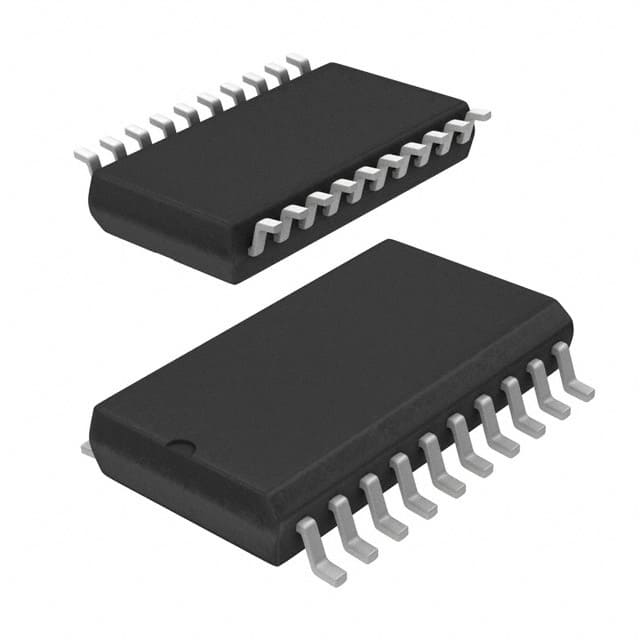CD74HCT574M
Product Overview
Category
CD74HCT574M belongs to the category of integrated circuits (ICs).
Use
It is commonly used in digital electronic circuits for data storage and transfer.
Characteristics
- High-speed operation
- Compatibility with TTL (Transistor-Transistor Logic) inputs
- Wide operating voltage range
- Low power consumption
Package
CD74HCT574M is available in a 20-pin SOIC (Small Outline Integrated Circuit) package.
Essence
The essence of CD74HCT574M lies in its ability to store and transfer digital data efficiently within electronic circuits.
Packaging/Quantity
CD74HCT574M is typically packaged in reels or tubes, with quantities varying depending on the supplier.
Specifications
- Supply Voltage: 2V to 6V
- Input Voltage: 0V to VCC
- Output Voltage: 0V to VCC
- Operating Temperature Range: -40°C to +85°C
- Maximum Clock Frequency: 25 MHz
- Number of Flip-Flops: 8
Detailed Pin Configuration
- GND (Ground)
- D0 (Data Input 0)
- D1 (Data Input 1)
- D2 (Data Input 2)
- D3 (Data Input 3)
- D4 (Data Input 4)
- D5 (Data Input 5)
- D6 (Data Input 6)
- D7 (Data Input 7)
- OE (Output Enable)
- CP (Clock Pulse)
- MR (Master Reset)
- Q0 (Flip-Flop Output 0)
- Q1 (Flip-Flop Output 1)
- Q2 (Flip-Flop Output 2)
- Q3 (Flip-Flop Output 3)
- Q4 (Flip-Flop Output 4)
- Q5 (Flip-Flop Output 5)
- Q6 (Flip-Flop Output 6)
- VCC (Supply Voltage)
Functional Features
- Data storage and transfer: CD74HCT574M can store data on its flip-flops and transfer it to the output pins upon receiving a clock pulse.
- Output enable control: The OE pin allows for enabling or disabling the output, providing flexibility in data flow control.
- Master reset capability: The MR pin resets all flip-flops to their initial state when activated.
Advantages and Disadvantages
Advantages
- High-speed operation enables efficient data processing.
- Compatibility with TTL inputs allows for easy integration into existing circuits.
- Wide operating voltage range provides versatility in various electronic systems.
- Low power consumption contributes to energy efficiency.
Disadvantages
- Limited number of flip-flops may restrict the complexity of data storage and transfer operations.
- Sensitivity to electrostatic discharge (ESD) requires proper handling during installation and usage.
Working Principles
CD74HCT574M operates based on the principles of digital logic circuits. When a clock pulse is received, the data present at the input pins is latched onto the flip-flops. This stored data is then available at the output pins until the next clock pulse arrives. The output enable pin controls whether the stored data is accessible at the outputs or not. The master reset pin resets all flip-flops to their initial state when activated.
Detailed Application Field Plans
CD74HCT574M finds applications in various fields, including:
- Microcontrollers: Used for interfacing microcontrollers with external devices, such as sensors and actuators.
- Communication Systems: Employed in data transmission and reception circuits.
- Memory Modules: Integrated into memory modules for data storage and retrieval.
- Industrial Automation: Utilized in control systems for data processing and signal manipulation.
Detailed and Complete Alternative Models
- SN74HCT574: Similar functionality with minor variations in specifications.
- MC74HCT574: Another alternative with comparable features and performance.
- 74HC574: A compatible model from the HC series, offering similar functionality.
These alternative models can be considered based on specific project requirements and availability.
Word count: 529 words
10個與CD74HCT574M在技術方案中應用相關的常見問題與解答
Sure! Here are 10 common questions and answers related to the application of CD74HCT574M in technical solutions:
Q: What is CD74HCT574M? A: CD74HCT574M is a type of octal D-type flip-flop integrated circuit (IC) that can be used for various digital logic applications.
Q: What is the purpose of CD74HCT574M? A: The purpose of CD74HCT574M is to store and manipulate digital data in electronic circuits, making it useful for tasks like data storage, synchronization, and signal processing.
Q: What voltage levels does CD74HCT574M support? A: CD74HCT574M supports a wide range of voltage levels, typically from 2V to 6V, making it compatible with both TTL and CMOS logic families.
Q: How many flip-flops are there in CD74HCT574M? A: CD74HCT574M contains 8 individual flip-flops, making it an octal (8-bit) device.
Q: Can CD74HCT574M be used for bidirectional data transfer? A: Yes, CD74HCT574M supports bidirectional data transfer, allowing data to be inputted and outputted through the same pins.
Q: What is the maximum clock frequency supported by CD74HCT574M? A: CD74HCT574M can operate at high clock frequencies, typically up to 25 MHz, enabling fast data processing in digital systems.
Q: Does CD74HCT574M have any built-in latches or registers? A: Yes, each flip-flop in CD74HCT574M has a built-in latch, allowing data to be temporarily stored before being transferred to the output.
Q: Can CD74HCT574M be cascaded to increase the number of flip-flops? A: Yes, multiple CD74HCT574M ICs can be cascaded together to increase the number of flip-flops and create larger storage registers.
Q: What is the power supply requirement for CD74HCT574M? A: CD74HCT574M typically operates with a single power supply voltage of 5V, although it can also work with other voltages within its specified range.
Q: Are there any special considerations when using CD74HCT574M in high-speed applications? A: Yes, in high-speed applications, it is important to ensure proper signal integrity, minimize noise, and follow recommended layout guidelines to maintain reliable operation.
Please note that these answers are general and may vary depending on specific datasheet specifications and application requirements.


